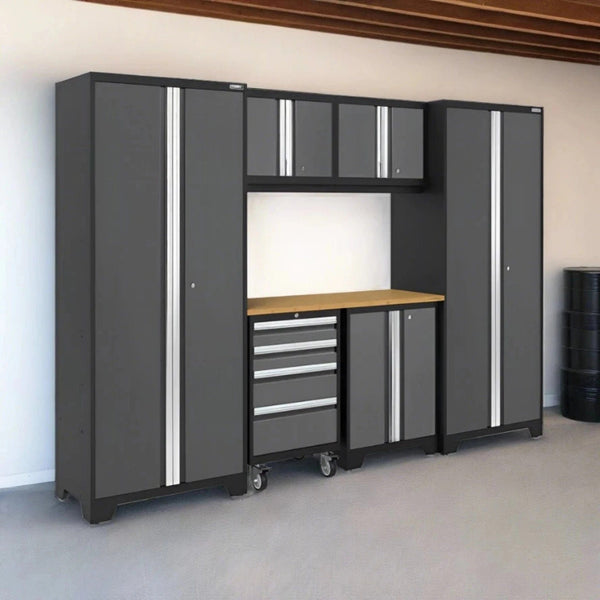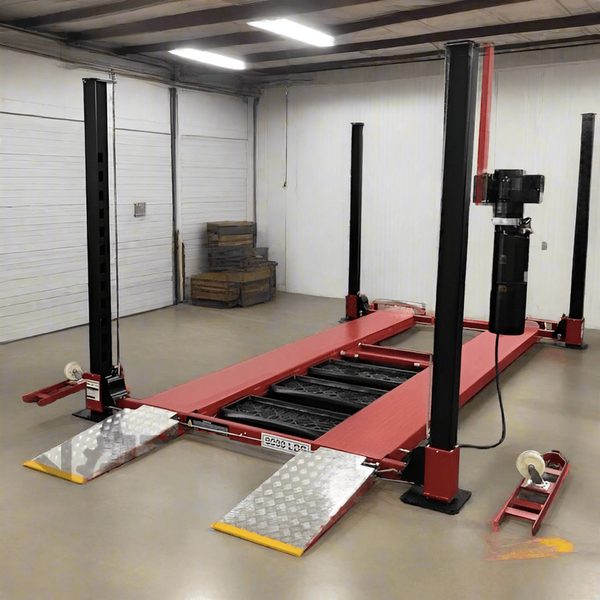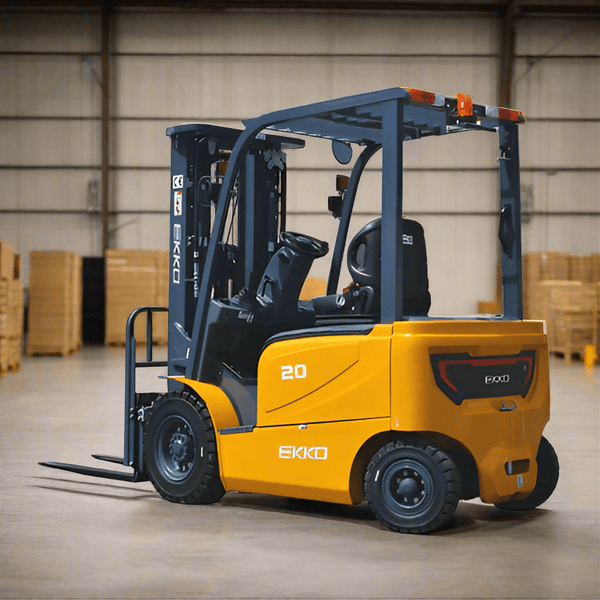
Are Single-Post Car Lifts Safe?
There’s no denying the appeal of single-post lifts. They’re super compact and convenient. But it’s fair to question the structural integrity of one post holding up thousands of pounds of steel, especially if you are going to be working under the vehicle.
So, are single-post car lifts safe? We get asked this all the time. But here’s the thing - safety has little to do with how many posts a car lift has, and more to do with well it’s designed, installed, and maintained.
The short answer is yes. Single-post lifts can absolutely be safe when built by a reputable manufacturer, anchored to the proper concrete slab, and used within its rated capacity.
These lifts are engineered with hydraulic safety locks, solid steel columns, and reliable lift carriages designed to keep your vehicle securely suspended.
But not all lifts are created equal, which is why the best thing you can do is buy a single-post car lift from one of the most trusted car lift brands here at My Garage Supplies. We’ve handpicked our car lifts from the industry’s top manufacturers, so you can shop with peace of mind.
What is a Single-Post Lift?
As the name suggests, these types of car lifts use one central column to raise and support a car off the ground. While a 2-post lift vs 4-post lift has a balanced structure across multiple contact points, these lifts use a reinforced upright with a hydraulic lift carriage to support the vehicle’s weight on one side.
The base is typically anchored to a reinforced concrete slab or, in portable models, stabilized with extended arms or outriggers. This style is commonly used for light-duty service work, vehicle storage, or space-saving in smaller garages.
They’re actually some of the best residential garage car lifts because they work great when floor space is limited, but vertical clearance allows for stacking or elevated parking.
Don’t let their size fool you, either. Quality 1-post lifts are surprisingly strong, often rated for 6,000 to 7,000 lbs or more. This is a convenient, reliable way to lift and store cars in tight spaces. That is, when properly installed and used within their limits.
So, are single-post car lifts safe?
Are Single-Post Car Lifts Safe?
Like we said from the start, you have very little to worry about regarding single-post lift safety as long as you source your lift from a reliable manufacturer, make sure it’s installed properly, and use it as it’s intended. Let’s look at the common safety features these lifts are equipped with.
Looking at the Safety Features on Single-Post Lifts
Safety is integrated into the very design of single-post car lifts. They come with features like:
- Hydraulic safety locks that engage automatically as the lift rises
- Heavy-gauge steel columns and stable bases or outriggers (for portable units)
- Load-holding valves that prevent sudden drops if pressure is lost
- Manual lowering controls that allow for controlled descent in the event of power failure
These features work together to keep the lift stable and give operators more control over the lift at all stages of use. But, how does the safety profile of single-post lifts stack up to the sturdier 4-post car lift or 2-post car lift?
How Single-Post Lifts Compare to 2-Post and 4-Post Lifts
All car lifts, be it a symmetric vs asymmetric lift or scissor lift vs 2-post lift, can be totally safe in the right circumstances.
2-post lifts give you better access to the vehicle’s undercarriage and are much more stable since they lift the vehicle at 4 different contact points from two posts instead of one. They give you more balance and security.
4-post lifts offer the highest degree of stability overall, though. The vehicle’s weight is distributed across four columns and the full length of its frame. They’re the best choice for both heavy vehicles and long-term storage.
The key takeaway from this conversation, though, is that single-post lifts are safe when used for the right job, within their rated capacity, and installed correctly. But that’s not always the case…
When Single-Post Lifts Are Not Recommended
Now, are single-post car lifts safe for all uses? Definitely not. There are a few scenarios in which we would not recommend using these lifts. These include:
- Heavy commercial use with oversized vehicles exceeding lift capacity
- Frequent wheel or suspension work, since single-post designs often limit wheel access
- Garages with uneven or substandard concrete, which may not support anchoring or load balance
In general, single-post lifts are the optimal choice for homeowners, hobbyists, or shops looking for portable storage or compact lifting solutions. They are not ideal for high-frequency, high-load use cases. Stick with a 2-post or 4-post lift for these applications.
Installation and Setup Risks to Be Aware Of
While the lift itself plays a part in safety, many issues stem from improper installation. That’s why it’s so important you 1) confirm the specifications of your garage to ensure it’s a good fit and 2) get the lift installed by a professional. Here are some of the risks:
- Incorrect concrete slab specs. So how thick does concrete need to be for a car lift? Most lifts require 4”+ of 3,000+ PSI concrete. Anything less can compromise anchor strength.
- Uneven floor surfaces, which can create tilt or instability
- Improper electrical setup, such as using underpowered outlets or loose wiring
- Inadequate anchoring or skipped torque checks, which reduce base stability
Always follow the manufacturer's installation guidelines and hire a professional if you're unsure. After all, the vast majority of lift-related failures are not a result of design shortcomings, but shortcuts during setup.
Tips on Staying Safe With a Single-Post Car Lift
You don’t need to be scared about using a single-post car lift when you choose the right one, get it installed properly, and use it correctly (including regular maintenance). Here are some tips on how you can protect yourself, your vehicles, and all those around you.
Choose a Lift From a Trusted Brand
The first thing you should do is think carefully about the specific lift you rely on day in and day out. Not all lifts meet the same standards for safety and reliability, after all.
Trusted manufacturers use certified materials, rigorous testing, and proven engineering to build lifts that hold up under pressure (literally). We recommend brands like AMGO, Atlas, and iDEAL, each known for its quality construction and industry compliance.
So, are single-post car lifts safe from My Garage Supplies? Yes - we’ve hand-selected single-post lifts from the industry’s best manufacturers. Our models are backed by clear specs and safety certifications, so you can feel confident making this investment in your shop.
Whether you’re looking for a portable parking lift like the Atlas PSP-6000 or a full-rise service lift like the AMGO SL-7, we’ll make sure you get a product that performs safely and fits your setup. Get in touch today for a personalized recommendation.
Get it Professionally Installed if Need Be
We keep saying improper installation is one of the biggest safety risks with any lift. It’s worth paying for peace of mind and having a certified technician install the lift if you're unsure about anchoring, electrical wiring, or slab requirements.
These experts can confirm correct torque on anchor bolts, proper leveling, and safe power connections. You’re spending thousands of dollars on the lift itself, you may as well invest a bit more in the assurance your lift will work well for years to come!
Always Follow Manufacturer Load Ratings and Guidelines
Every lift has a maximum rated capacity. Don’t exceed it, and don’t guess. Always check the manual and include the total weight of the vehicle, including fluids, cargo, or modifications. Using a lift beyond its rating can cause hydraulic failure or structural stress over time.
Inspect the Lift Before Each Use
You should always do a quick check for signs of damage, wear, or leaks before lifting any vehicle. Make sure the safety locks are working, cables are in good condition, and there’s no hydraulic seepage at the base or cylinder. It sounds simple, but this can prevent major issues.
Ensure Proper Vehicle Positioning
Uneven loads are a common cause of lift instability, so position the vehicle so that its center of gravity aligns with the lift’s rated lifting zone. Don’t let weight hang unevenly, and never try to lift a car that’s too long or too wide for your specific model.
Keep the Working Environment Clean and Dry
Slippery or cluttered floors increase the risk of trips, electrical hazards, or misjudged alignment when driving onto the lift. Keep the area around the base free of oil, debris, or water. Make sure power cables are secure and away from foot traffic. This is just good shop hygiene.
Train Anyone Who Uses the Lift
Make sure anyone using the lift understands the controls, lock positions, and emergency lowering process. Post clear usage instructions near the lift, and limit access to people who’ve been properly trained - be it in a home or commercial shop.
Closing Thoughts on Single-Post Car Lift Safety
So are single-post car lifts safe? In closing, these can be a completely safe, efficient solution for storage or light-duty service. At the risk of sounding like a broken record, there are just a few caveats: you must use the right lift, install it correctly, and follow basic safety practices.
Remember, the number of columns don’t dictate safety or stability. It’s about the quality of the equipment and how you treat it. Invest in a lift that’s built to perform, and it will work safely for years to come.
Need help choosing the right model for your garage? Talk to us today. Connect with our experts for one-on-one support and we’ll make sure you get a lift you can count on for the long haul!



